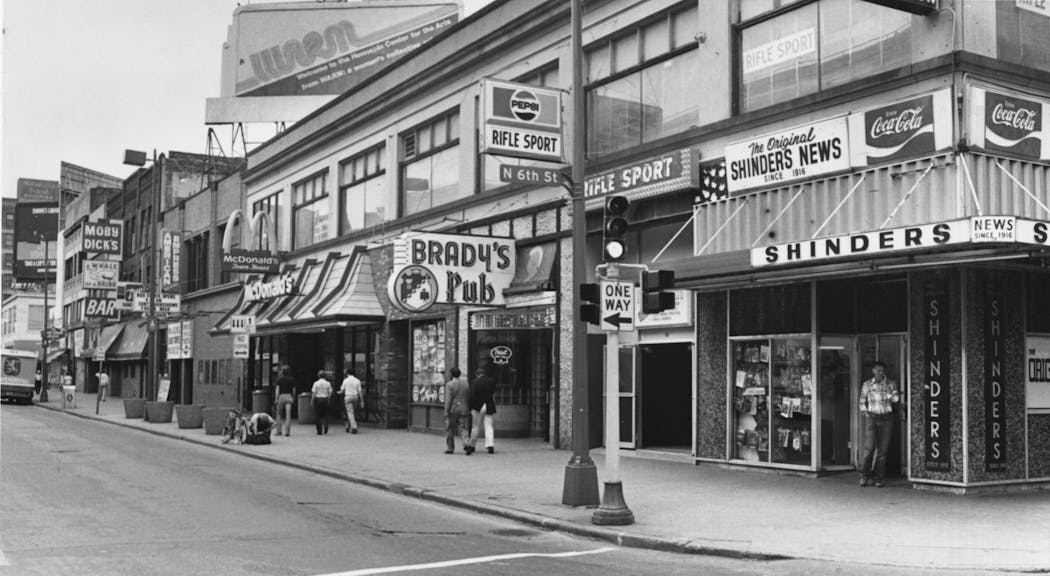What does downtown need the most, aside from office workers to return?
Small, unique buildings. Even small, boring buildings will do.
When people look at old pictures of downtown, they sigh with nostalgia over the crowded streets, the thrum of urban vitality.
That didn't happen just because there were department stores and movie theaters downtown. It wasn't because everything was big. It was because there was also much that was small.
Consider a small structure, the fate of which seems uncertain: the Minneapolis Club annex, most recently a Life Time fitness.
Built in 1974, it's on 7th Street, between 2nd and 3rd avenues, is empty now, but it's never looked occupied. It's a peculiar building. It's not beloved. Blank facade, except for some opaque windows on the side, and a row of windows over the door. It looks like a bunker, but a stylish one.
The owners recently proposed demolishing it, and using the space for parking. In the current anti-car mood, this is like paving half of Loring Park and opening up the rest for coal mining.
It's not just the loss of a building for parking that might rankle. It's the loss of something that wasn't enormous.
The recent revitalization of downtowns across the country, Minneapolis included, required the replacement of boring, ugly parking lots with new structures.
The Kraus-Anderson project (5th Avenue and 8th Street) filled a mostly vacant block with a high-rise apartment building, offices, a brewery, a hotel.
The Larking apartment building (Portland Avenue and 8th Street) replaced a drive-through bank. The new Sora apartments (6th Street and 5th Avenue replaced a surface lot.
But it wasn't always the case.
Until the building boom of the past 10 years, almost every structure of note was built on the graves of older buildings.
The city didn't have acres of parking lots. Almost every block was filled with something — creaky old homes, row houses, small industrial facilities, and stores of all sorts. Developers tore down old structures to put up the new ones, and, in most cases, one enormous building replaced a dozen smaller, individual buildings.
A smaller-scaled downtown isn't as impressive as downtowns today, if you judge a city by its tall, shiny towers. But it was far more useful, humanely scaled and diverse in purpose. It was much more interesting, simply because each individual building had its own character. On any block you might find six or seven small structures, each being two or three stories tall.
The old pictures of downtown Minneapolis and St. Paul seem tantalizing and mysterious. What went on in the second floor of that shop? How many stores occupied the ground floor? And who were the shopkeepers and clerks who sat looking out the window at the passersby?
In the case of the Gateway — the skid-row district razed in the early 1960s for urban renewal — the pictures show us little but bars, liquor stores and flophouses. But even that notorious neighborhood once had a prime, when each modest structure had its own character, its own purpose and the owner's name on the cornice.
It's all gone now, and nothing that replaced it carried its varied character into the future. From small buildings to buildings that take up a block. From cubbyhole nooks to law firms stacked high.
So, did we learn anything from the wholesale destruction of the Gateway? Not really.
The same thing was done on a smaller scale on Block E, a collection of tired old shops on Hennepin Avenue between 6th and 7th streets. The block was razed, piecemeal, in the late 1980s and '90s. In 2001, an ill-considered entertainment complex opened on the spot.
As tawdry as the block had become, it was interesting, with buildings dating back to the early days of the 20th century. If Block E hadn't been developed into what is now Mayo Clinic Square, it might have been rehabbed, the theaters restored instead of razed, the stolid Jewelers Exchange building converted to lofts or a hotel.
The City Center development, built in 1983, replaced the lurid and wonderful Gopher theater marquee, cafes, a Bridgeman's Ice Cream Parlor, shops for hats and shoes. Down it went for an inward-looking bunker that appeared to expect not shoppers, but invaders.
If it hadn't been for City Center and Block E, Hennepin would have been the most extended, intact old-style street downtown — a time capsule changing only as the shop signs and marquees changed, and the retail and restaurants renewed and refreshed the street.
For downtown Minneapolis, the North Loop now has the most old-style buildings, but they tend to be massive warehouses, rather than inviting two-story buildings.
If I had a message for developers, it would be this: Go big, yes, build tall. But here and there, now and then, think small.

A Minnesota field guide to snow shovels: Which one's best?
Sign up for Star Tribune newsletters



